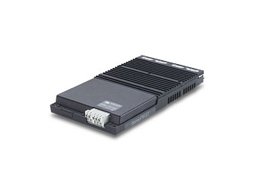
The MI-ComPAC is a complete single, dual, or triple output DC-DC power supply that delivers up to 300 watts from inputs of 28 or 270 Vdc. Each unit incorporates one, two, or three component-level Vicor MI-200 family DC-DC converters.
The MI-ComPAC meets the conducted emissions and susceptibility specifications of MIL-STD-461C/D/E and offers complete input transient, surge and spike protection to the most severe levels of MIL-STD-1275A/B/D, MIL-STD-704A-F, and DO-160E. Reverse polarity protection and over/undervoltage lockout provide additional safeguards against potentially damaging line conditions. The MI-ComPAC also features a logic enable/disable.
- 28 and 270 Vdc
- 2 – 48 Vdc
- 50 – 300 W
- Up to 81%
- See mechanical drawing on data sheet
- Up to 5 W/in3
- One, two or three outputs
- MIL-STD-461C/D/E EMI compliance
- MIL-STD-704A-F, 1275A/B/D, and DO-160E compliance for transients ad spikes
- Reverse polarity protection
- ZCS Power architecture
- Low noise FM control
Download Entire Manual
Download Individual Chapters
- Zero-Current Switching
- DC-DC Converter Pinouts
- Module Dos and Donts
- Overcurrent Protection
- Output Voltage Trimming
- Multiple Gate In Connections
- Applications Circuits / Converter Array Design Considerations
- Using Boosters and Parallel Arrays
- EMC Considerations
- Optional Output Filters
- Battery Charger (BatMod)
Filter and Front-End Module Chapters
- AC Input Module (AIM / MI-AIM)
- Harmonic Attenuator Module (HAM)
- Input Attenuator Module (IAM / MI-IAM)
- Ripple Attenuator Module (RAM / MI-RAM)
- Offline Front End
Power System Chapters
- DC Input Power System (ComPAC / MI-ComPAC Family)
- AC Input Power System (FlatPAC Family)
- AC Input Power System (PFC FlatPAC)
General Chapters
- cURus – UL 60950-1, CSA 60950-1
- cURus – UL 1604, CSA C22.2 No. 213-M1987 Class I, Div. 2
- cTÜVus – EN 60950-1, UL 60950-1, CSA 60950-1
- CE Markked – Low Voltage Directive (2006/95/EC)
- CB Certificate – IEC 60950-1:2001
| ComPAC / MI-ComPAC | ||||||||
| Drawing Number | Description | RoHS | Technical Drawing | |||||
| 25350 | Outline Drawing for ComPAC, „L“ Configuration (Single) | PDF | DXF | ||||||
| 25349 | Outline Drawing for ComPAC, „M“ Configuration (Dual) | PDF | DXF | ||||||
| 25351 | Outline Drawing for ComPAC, „N“ Configuration (Triple) | PDF | DXF | ||||||
| 25353 | Outline Drawing for ComPAC, „P“ Configuration (Dual) | PDF | DXF | ||||||
| 25352 | Outline Drawing for ComPAC, „Q“ Configuration (Triple) | PDF | DXF | ||||||
| 25348 | Outline Drawing for ComPAC, „R“ Configuration (Triple) | PDF | DXF | ||||||
| ComPAC / MI-ComPAC Conduction Cooled | ||||||||
| Drawing Number | Description | RoHS | Technical Drawing | |||||
| 17934 | Outline Drawing for ComPAC, „L“ Configuration (Single) | -CC* | PDF | DXF | |||||
| 17935 | Outline Drawing for ComPAC, „P“ Configuration (Dual) | -CC* | PDF | DXF | |||||
| 17936 | Outline Drawing for ComPAC, „M“ Configuration (Dual) | -CC* | PDF | DXF | |||||
| 17937 | Outline Drawing for ComPAC, „Q“ Configuration (Triple) | -CC* | PDF | DXF | |||||
| 17938 | Outline Drawing for ComPAC, „R“ Configuration (Triple) | -CC* | PDF | DXF | |||||
| 17939 | Outline Drawing for ComPAC, „N“ Configuration (Triple) | -CC* | PDF | DXF | |||||
| * For conduction-cooled package add -CC to the end of the part number. | ||||||||
These calculator programs allow users to determine values that help with accessory
component selection for power system design.
Trim Resistor Calculators
- Trim resistors for fixed output voltage trimming
- Trim resistors for variable output voltage trimming
- Trim resistors for setting float voltage and charge current in battery chargers designed with BatMod modules
Thermal Calculators
- Thermal data and heat sink selection tool
This is a downloadable Excel file.
- MIL-COTS MicroRAM – Output Ripple Attenuator Module – The MicroRAM combines both active and passive filtering to achieve greater than 40 dB of noise attenuation from over a range of 3 – 30 Vdc.
- MI-RAM – Ripple Attenuator Module– MI-RAM may be connected to MI-200 or MI-J00 converters with output voltages from 5 – 50 Volts, to limit total output noise to less than 3 mV peak-to-peak at loads up to 20 Amps.
